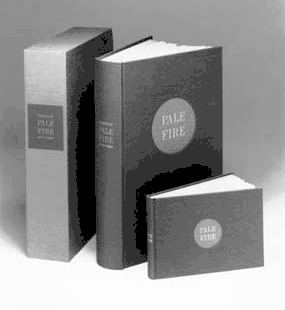Pale Fire

For better or worse, it is the commentator who has the last word.—Professor Charles Kinbote
Pale Fire is a 1962 novel by Vladimir Nabokov. It ostensibly concerns a 999 line poem by nationally famous poet John Shade, which appears in the book with extensive commentary by Shade's neighbor and fellow professor Charles Kinbote. Once the commentary gets underway however, it is clear Kinbote's interpretation differs wildly from the information available in the poem itself, which is soon eclipsed by the mad, paranoid, telescoping story that emerges from Kinbote's intrusion. Shade is unavailable to correct the work, having been shot moments before by a man who was likely trying to kill someone else entirely.
As inconsistencies in the narrative begin to pile up, more and more of the novel's premises become suspect, and the reader navigates through multiple layers of reality formed by variable amounts of truth and lies, while simultaneously navigating Kinbote's labyrinthine footnotes that allow the book to be read in any order the reader chooses.
Likewise, the story can be read any way the reader chooses (though not every layer of reality is created equal): as an exile's loving capsule of his vanished homeland, an international political thriller, a sad portrait of a lonely madman, a parent's ode to his dead child, or a scathing satire of academia.
According to The Other Wiki: "The interaction between Kinbote and Shade takes place in the fictitious small college town of New Wye, Appalachia, where they live across a lane from each other, from February to July, 1959. Kinbote writes his commentary from then to October, 1959, in a tourist cabin in the equally fictitious western town of Cedarn, Utana."
- All of the Other Reindeer: Kinbote's social status at the university, with the (possible) exception of his relationship with Shade.
- Anachronic Order: Most of the novel consists of footnotes that refer the reader all around the book.
- Author Appeal: References to butterflies, like every one of Nabokov's books.
- Author Avatar: Near the end, implied to be one of Kinbote's layers.
- Bilingual Bonus: "Zembla" is an old way of transcribing Земля (today generally transcribed zemlya or zemlja), which means "land" in Nabokov's native Russian. It's also a reference to The Prisoner of Zenda.
- Completely Missing the Point: Kinbote throughout the entire book.
- Dead Little Sister: Hazel Shade, John Shade's daughter. He wrote the poem Pale Fire largely to cope with his grief, which makes her death the seed for the entire book.
- Death of the Author: Nabokov hated this trope and was happy to tell you exactly what his books meant. When he stated in an interview what he thought happened to the novel's narrator, one critic called it "authorial trespassing," and invited readers to completely ignore it.
- Depraved Homosexual: Kinbote.
- Die for Our Ship: Kinbote absolutely adores Shade, while looking for every opportunity to put down his wife Sybil, including claiming certain parts of the poem are not about her when they explicitly are.
- Expy: Professor Pnin (from Nabokov's previous novel) makes a brief appearance near the end, as does "Hurricane Lolita."
- Footnote Fever: Nabokov and Kinbote have it. The novel is not quite as loony as House of Leaves, but was clearly an inspiration for it.
- Ho Yay: Kinbote for Shade, border-lining Stalker with a Crush
- In the Original Klingon: Kinbote suggests a Zemblan etymology for Shakespeare's last name as being "the most probable".
- It's All About Me: The sentiment that allows Kinbote to write almost three hundred pages of "commentary" on his murdered neighbor's poem, imposing his own story upon it along the way.
- Jerkass: Kinbote. Although he could fall anywhere on the scale between here and The Woobie, depending on how pathetic you think he is.
- Literary Allusion Title: "Pale Fire" comes from Act IV, scene iii of Shakespeare's Timon of Athens, a fact Shade notes in his poem.
- And this Shout-Out to Shakespeare is, by Kinbote, mistranslated into English from a Zemblan copy of Timon of Athens without the Arc Words, so he's Completely Missing the Point.
- Meaningful Name: Many, some overlapping with Significant Anagram.
- Meta Fiction
- Metafictional Title: Pale Fire the book is named after Pale Fire the poem.
- Mysterious Past: Real, or imagined and achingly desired.
- Noble Fugitive: King Charles the Beloved.
- Post Modernism
- Ruritania: A highly idealized example in Zembla[1].
- Shout-Out: Many.
- Also, The X-Files episode "Jose Chung's From Outer Space" shouts out Pale Fire, with a delusional character receiving a revelation from an alien named "Lord Kinbote."
- Significant Anagram: Very significant.
- Small Name, Big Ego: Kinbote again.
- The Un-Reveal: A big part of why the book is so great: there is just enough information given to deny any single interpretation as valid.
- Unreliable Narrator: I'd give example's name, but I'm pretty sure he lied about that too.
- Viewers Are Geniuses: Or else Nabokov wrote it to amuse himself, and he just doesn't care if you get it.
- ↑ A distant northern land